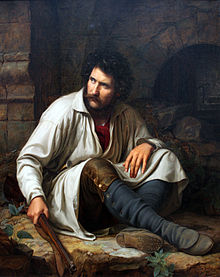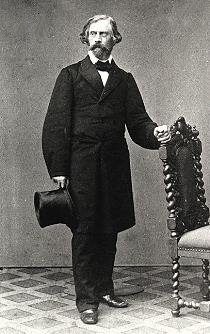Theodor Hildebrandt
Theodor Hildebrandt (born July 2, 1804 in Stettin , † September 29, 1874 in Düsseldorf ) was a German painter and coleopterologist . He was an important representative of the Düsseldorf School of Painting .
Life
Born in Stettin as the son of a master bookbinder, Hildebrandt went to the art academy in Berlin at the age of sixteen in 1820 . Here he was first a student of Johann Gottfried Niedlich , from 1823 then of Friedrich Wilhelm von Schadow . When Schadow was appointed to the Düsseldorf Art Academy in 1826 , Hildebrandt also moved to Düsseldorf together with Julius Huebner , Carl Friedrich Lessing , Heinrich Mücke , Christian Köhler and Carl Ferdinand Sohn . After completing his studies in Düsseldorf, he got a job as an assistant teacher there in 1832. Four years later he was appointed professor, and as such he became an influential lecturer at the Düsseldorf School of Painting.
Hildebrandt was instrumental in founding the Malkasten artists' association . In 1845 Wilhelm Camphausen illustrated him by painting Othello and Desdemona in his studio .
In 1854 he fell ill with a mental illness and since then has only been able to work temporarily. From 1866 to 1869 he once again led a master class. But after it had survived a protracted brain ailment, it no longer achieved its previous meaning. The last few years of his life he was very sick and not a single picture was taken. Hildebrandt died at the age of 70 on September 29, 1874 in Düsseldorf and found his final resting place in the Golzheimer Friedhof .
Hildebrandt was awarded the Red Eagle Order IV class .
Systematic research into the insect fauna of Düsseldorf and the surrounding area began in the 19th century. Theodor Hildebrandt and Julius Eduard Braselmann (1810–1872), teachers at the Evangelical Free School in Düsseldorf, studied the beetle fauna of Düsseldorf from 1830 onwards . In the "Overview of the Beetle Fauna of the Rhine Province" by Arnold Förster , published in 1847, 2747 species of beetles were listed on 120 pages, 1400 of them for the city of Düsseldorf, with Hildebrandt and Braselmann as informants. Hildebrandt owned a very large collection of beetles. In 1851 he was visited by the still student Gustav Kraatz from Bonn, who in 1856 became a founding member of the " Entomological Association Berlin".
Theodor Hildebrandt had eight children, three sons and five daughters. His daughter Friederike Auguste (born August 27, 1837) also became a painter. She married Wilhelm Eduard Voss in 1861. His son Johann Maria Hildebrandt (1847–1881) became a botanist and explorer.
Masterpieces and reception
After he had already achieved some notoriety in 1832 with his historicist genre painting The Warrior and His Child , he achieved his artistic breakthrough in 1835 with the history painting The Murder of the Sons of Edward IV . It illustrates the corresponding plot in the drama Richard III. by William Shakespeare . It was inspired by the painting The Murder of the Sons by Paul Delaroche , created in 1830 and dedicated to the same subject . Hildebrandt traveled to Paris in 1830 to study this picture. The larger version went to the von Spiegel collection in Halberstadt , the smaller one to the collection of Count Atanazy Raczyński in Berlin (now the National Gallery ). This work also became known through the copper engraving by Friedrich Knolle .
All these pictures already show the influence of the Netherlands, which he visited for the first time in 1829, and the school of Gustave Wappers - less the impressions of his Italian trip (1830–31), which were unable to influence his realistic tendency.
Friedrich von Uechtritz judged the painting The Murder of Edward IV's Sons in 1840: “But above all, the two princes of Edward's sons and especially the younger one must be praised as a masterpiece in conception and execution, if one thinks the quiet one to feel the pure and fresh breath of the slumbering child, to see the moist scent of slumber rise from the pores of the higher colored cheeks. [...] "
Ignoring the characteristic of the sentimental and idyllic reinterpretation of a murderous act in the character of the picture, contemporary critics praised the “lifelike” painting of “deceptive truth” in the “lovely” expression of sleeping children. In this sense, Hildebrandt is one of the first pioneers of the realistic direction in Düsseldorf and has just as much merits for his tasteful security in the reproduction of nature, especially in portraits, as for his talent for composing in historical pictures with dramatic content.
Works (selection)

- Fist in the cave .
- Gretchen in the dungeon . 1825.
- King Lear in mourning for Kordelia . 1826 (his friend Ludwig Devrient modeled it for him)
- Romeo and Juliet . 1827.
- Chlorinde . 1828.
- The robber . 1829.
- Judith , about to kill Holofernes . 1830.
- The warrior and his child . (1832, known from Eduard Mandel's copperplate engraving, National Gallery in Berlin).
- The storyteller .
- The sick councilor . 1834.
- Four singing choirboys .
- Christmas Eve . 1840.
- Reception of Cardinal Wolsey at the monastery . 1842.
- Doge and daughter . 1843.
- Judith . 1844.
- The Italian woman reading letters . 1845.
- Othello and Desdemona . 1847.
- Julia, taking the sleeping potion . 1853.
- Arthur and de Burgh from " King John " . 1855.
- Kordelia, reading the letter to Kent .
- Prince Friedrich of Prussia .
- Princess Albrecht of Prussia .
- Princess Luise of Prussia with her sons Georg and Alexander at Rheinstein Castle , 1829 (in the Düsseldorf City Museum )
- Prince George of Prussia .
- Gerhardt Wilhelm von Reutern 1838.
- Zhukovsky State Councilor .
- Count Anton von Stolberg-Wernigerode .
- Minister von der Heydt .
- Johann Wilhelm Colsman (silk manufacturer, 1800 - 1856) and Emilie Colsman born. Bleckmann (1801-1886) , 1853.
- Friedrich August Feldhoff (silk ribbon manufacturer, 1801 - 1873) and Theodore Feldhoff born. Kalkhoff (1801-1893) , 1853.
- Peter Dietrich Conze (silk manufacturer, 1783 - 1861) and Sophia Conze b. Waldhausen (1793-1888) , 1853.
- Prince George of Prussia .
- Baron Wappers .
Illustrations (selection)
- In: Album of German Art and Poetry. With woodcuts based on the artist's original drawings, made by R. Brend'amour. Edited by Friedrich Bodenstedt. - Berlin: Grote, 1867. Digitized edition of the University and State Library Düsseldorf
- In: Reinick, Robert. Songs by a painter with drawings by his friends on the margins. - between 1836 and 1852.
- Songs by a painter with drawings by his friends on the margins. - Düsseldorf: Schulgen-Bettendorff, 1836, test print. Digitized edition of the University and State Library Düsseldorf
- Songs by a painter with drawings by his friends on the margins. - Düsseldorf: Schulgen-Bettendorff, 1838, colored portfolio edition. Digitized edition of the University and State Library Düsseldorf
- Songs by a painter with drawings by his friends on the margins. - Düsseldorf: Schulgen-Bettendorff, 1838. Digitized edition of the University and State Library Düsseldorf
- Songs by a painter with drawings by his friends on the margins. - Düsseldorf: Buddeus, between 1839 and 1846. Digitized edition of the University and State Library of Düsseldorf
- Songs by a painter with drawings by his friends on the margins. - Leipzig: Vogel, approx. 1852. Digitized edition of the University and State Library Düsseldorf
- "Blabs obtusa Sturm" (blunted grief beetle / dead beetle)
literature
- Moritz Blanckarts : Hildebrandt, Theodor . In: Allgemeine Deutsche Biographie (ADB). Volume 12, Duncker & Humblot, Leipzig 1880, p. 405 f.
- Eckhard Wendt: Stettiner Lebensbilder (= publications of the Historical Commission for Pomerania . Series V, Volume 40). Böhlau, Cologne / Weimar / Vienna 2004, ISBN 3-412-09404-8 , pp. 237-239.
Web links
Footnotes
- ↑ (...) Hildebrandt has a very peculiar love of beetles, of which he has already put together an important collection. (...) , in Düsseldorfer Kreisblatt and Daily Anzeiger (No. 277), dated October 11, 1843
- ^ JE Braselmann (born March 26, 1810 in Stollberg, † 1872 in Düsseldorf), educator. From August 15, 1829 at the Protestant free school in Düsseldorf, founding member of the "Society for Insect Science" (1866). Informer at Förster. From the beginning he was a member of the Natural History Association Bonn in whose negotiations he published three coleopterological papers in Vol. 1, Vol. 2 and Vol. 6. (…) Karl Hupp sen. Took over his collection of 2400 species in 45 boxes. and it went to the ESK Krefeld integrated with his collection. , at koleopterologie.de, accessed on February 27, 2020
- ↑ Theodor Hildebrandt 1804–1874: “Hildebrandt owned a very large collection of Goliathids, Dynastids, Cerambycids, Buprestids and Cetonids.” , On koleopterologie.de, accessed on February 27, 2020
- ↑ Bettina Baumgärtel (ed.): The Düsseldorf School of Painting and its international impact 1819–1918 . Michael Imhof Verlag, Peterberg 2011, ISBN 978-3-86568-702-9 , Volume 2, p. 181 ff.
- ↑ Bettina Baumgärtel, p. 183.
- ^ Ute Ricke-Immel: The Düsseldorf genre painting . In: Wend von Kalnein (Ed.): The Düsseldorf School of Painting . Verlag Philipp von Zabern, Mainz 1979, ISBN 3-8053-0409-9 , p. 151.
- ↑ Drawing Fig. 1 by Theodor Hildebrandt , in Ein monstöser Blaps obtusa St. in description and drawing , communicated by JE Braselmann, Düsseldorf, approx. 1850
| personal data | |
|---|---|
| SURNAME | Hildebrandt, Theodor |
| BRIEF DESCRIPTION | German painter |
| DATE OF BIRTH | July 2, 1804 |
| PLACE OF BIRTH | Szczecin |
| DATE OF DEATH | September 29, 1874 |
| Place of death | Dusseldorf |



